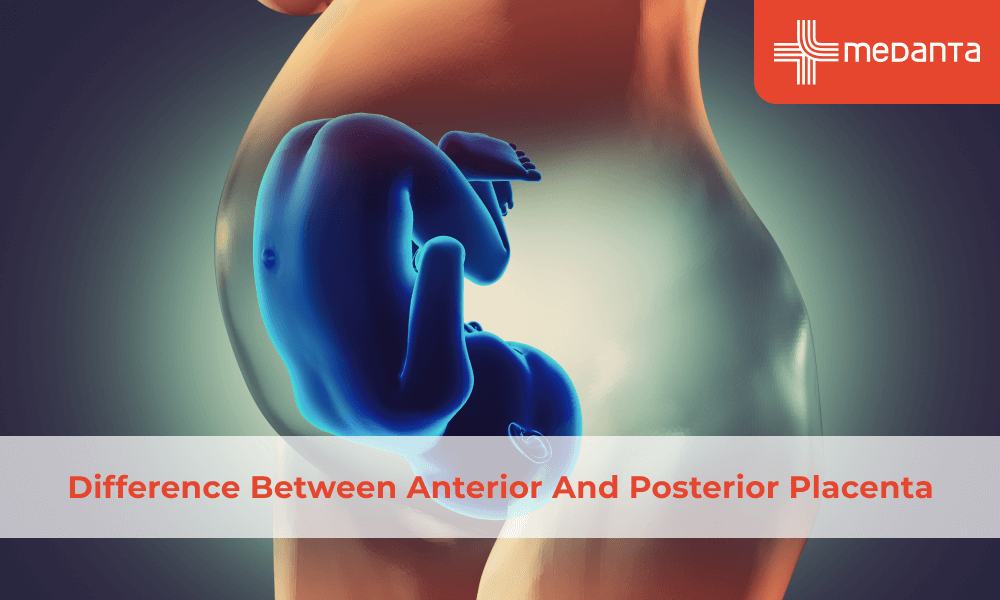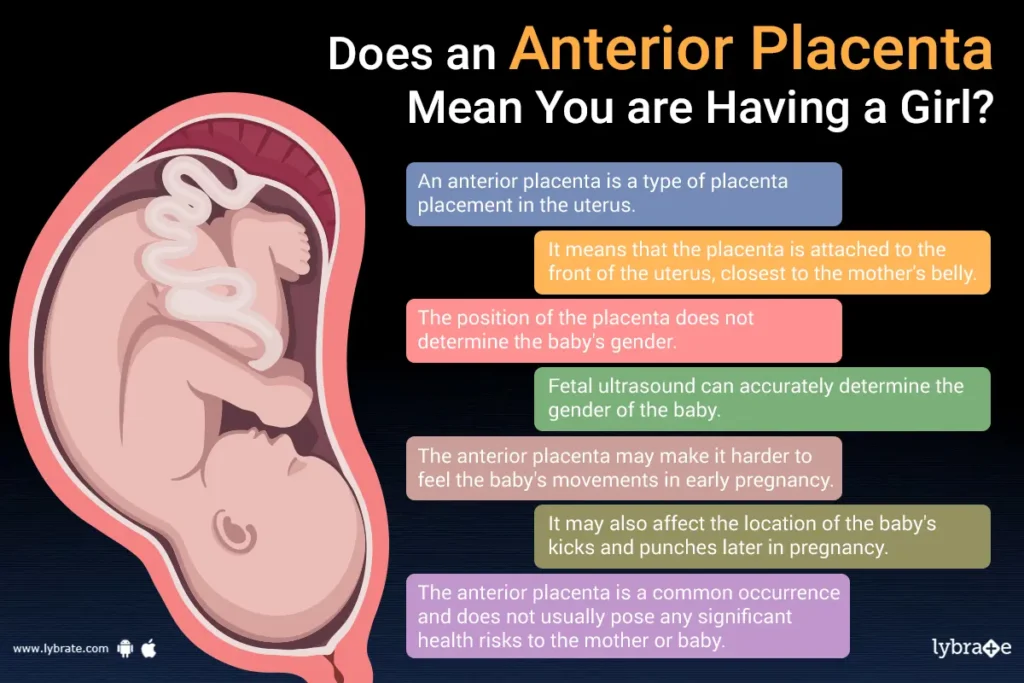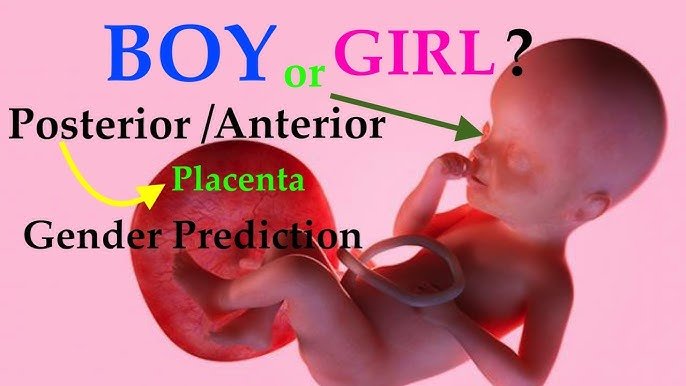Introduction
Every expecting parent feels a rush of curiosity about their baby’s gender long before the big ultrasound day. Over the years, many gender prediction theories have circulated — from belly shape to food cravings — and one of the most discussed in recent times is the “anterior placenta and gender” theory. This idea suggests that the position of the placenta, especially when located on the front wall of the uterus (anterior), could indicate whether you’re carrying a boy or a girl. According to common belief, an anterior placenta means you’re more likely to have a girl, while a posterior placenta points to a boy.
But is there any science behind this? Or is it just another pregnancy myth that spreads easily online? Let’s take a detailed, evidence-based look at what an anterior placenta really means, what research says about its connection to baby gender, and why this theory persists.

What Is an Anterior Placenta?
The placenta is one of the most vital organs during pregnancy. It connects the baby to the mother’s uterus and supplies oxygen, nutrients, and hormones while removing waste products from the baby’s blood.
When doctors describe your placenta as anterior, they mean it’s attached to the front wall of your uterus, closest to your belly. This is completely normal and happens in many pregnancies. Other possible placements include posterior (toward your back), fundal (at the top), lateral (on the side), or low-lying (close to the cervix).
Having an anterior placenta is not a complication. It simply describes where the placenta implanted when the embryo first attached to the uterine wall. Since this happens very early in pregnancy, it’s a matter of chance — not something influenced by diet, lifestyle, or the baby’s chromosomes.
One minor effect is that an anterior placenta may cushion the baby’s movements, so kicks might feel lighter or be felt later than usual. Otherwise, it’s just another healthy variation of a normal pregnancy.
Where the Theory Came From
The belief that placenta position predicts gender has its roots in traditional ideas and modern social media trends. Many mothers noticed patterns in their own pregnancies — for example, “I had an anterior placenta and a girl” — and began sharing these experiences online. Over time, the idea grew into what many call the anterior placenta gender theory.
A modern version of this theory appeared through something called the Ramzi method. This theory claims that the side of the placenta’s implantation in early ultrasound images can predict gender: right-sided for boys and left-sided for girls. Later, some people simplified it to say “front means girl” and “back means boy.”
However, these claims are based on anecdotal observations, not large-scale, peer-reviewed research. Scientists and obstetricians generally view the Ramzi method and the anterior-placenta gender theory as unproven and unreliable.

What Research Actually Shows
Several scientific studies have investigated whether placental location truly correlates with fetal sex. The findings are inconsistent, and most medical professionals agree that the placenta’s position does not determine gender.
Here’s what research tells us:
- Placenta placement is random.
The placenta develops wherever the fertilized egg implants. This process is natural and not influenced by the baby’s chromosomes (XX or XY). - Small studies have shown mixed results.
Some small studies suggested slightly higher rates of female babies with anterior placentas, but larger, better-controlled research found no significant difference. In other words, any apparent connection may be coincidence rather than cause and effect. - Most experts find no link.
Obstetricians widely agree that there is no scientific basis for using placenta position to predict gender. Fetal sex determination depends entirely on genetics — specifically whether the sperm carries an X or Y chromosome — not on where the placenta attaches. - Placenta position can change.
As pregnancy progresses and the uterus expands, the placenta may appear to “move.” It doesn’t actually detach, but as the uterus stretches, its relative position shifts. This makes early predictions based on placental location even less reliable.
So, despite the popularity of the claim, the medical consensus is clear: anterior placenta and gender are not scientifically connected.
Why the Myth Persists
Even though science doesn’t back it, the anterior placenta gender myth remains popular — and there are a few reasons why.
- Human nature loves patterns.
People are naturally drawn to patterns and coincidences. If a few parents notice that their anterior placenta pregnancies resulted in girls, it feels meaningful — even when it’s just chance. - Confirmation bias.
Once someone hears “anterior means girl,” they tend to remember cases that confirm it and ignore those that don’t. This selective memory helps the myth spread. - Social media and online forums.
Platforms filled with pregnancy stories make it easy for unverified claims to go viral. A few shared experiences can quickly turn into “common knowledge.” - The excitement of guessing.
Waiting for gender confirmation can feel long and suspenseful. Many parents enjoy playing with harmless prediction theories while waiting for official results.
While there’s no harm in guessing, it’s essential to treat placenta-based predictions as entertainment — not medical fact.

Does Placenta Position Affect Pregnancy in Other Ways?
Although it doesn’t determine your baby’s gender, an anterior placenta can slightly influence other aspects of pregnancy.
- Feeling Baby Movements:
Since the placenta is between the baby and your belly, you may feel kicks later than friends with posterior placentas. Most women with anterior placentas start feeling movement around 20–22 weeks instead of 16–18 weeks. - Ultrasound Clarity:
Sometimes, it can make it a bit harder to get clear ultrasound images, especially early on. Experienced technicians can still visualize everything they need. - Fetal Heartbeat:
It might be a little harder to hear your baby’s heartbeat using a Doppler in early pregnancy because the placenta cushions the sound waves. - Delivery:
In most cases, an anterior placenta doesn’t affect labor or delivery at all. However, if it’s very low and covers the cervix (a condition known as placenta previa), it may require special monitoring.
In general, an anterior placenta is considered completely normal and healthy. It rarely causes complications and simply means your placenta attached to the front wall of your uterus instead of the back.
How to Accurately Determine Baby Gender
If you’re eager to know your baby’s sex, several reliable medical methods exist — far more accurate than placenta predictions.
- Ultrasound (Anatomy Scan):
Around 18–22 weeks, your doctor performs a detailed anatomy scan. If the baby is positioned well, the technician can often identify the sex with about 95% accuracy. - Non-Invasive Prenatal Testing (NIPT):
From as early as 9–10 weeks, a simple blood test can detect fragments of your baby’s DNA in your bloodstream. NIPT is over 99% accurate in determining fetal sex. - Chorionic Villus Sampling (CVS):
Conducted between 10–13 weeks, this test samples placental tissue and can definitively identify chromosomal sex. It’s usually done for medical reasons, not just curiosity. - Amniocentesis:
Around 15–20 weeks, doctors can test amniotic fluid for chromosomal information. This method is 100% accurate but is invasive and carries minor risks.
These methods are based on genetic and anatomical evidence — not speculation — and are the only trustworthy ways to confirm your baby’s sex before birth.
Expert Opinion: What Doctors Say
Obstetricians and sonographers consistently emphasize that the position of the placenta does not reveal gender. The placenta’s location depends on where the embryo implants, which is a random process unrelated to the baby’s chromosomes.
Medical professionals caution against using online theories like the Ramzi method or anterior-placenta predictions as anything more than fun. They encourage parents to wait for medical testing and to avoid drawing conclusions based on unverified social media charts.
Doctors also highlight that focusing too much on gender can sometimes distract from what truly matters — ensuring a healthy pregnancy and monitoring fetal development properly.
In short, while guessing the baby’s gender can be fun, reliable results always come from verified medical scans and tests, not the placenta’s position.

The Role of Genetics in Determining Gender
Understanding how a baby’s gender is determined helps clear up why placenta position cannot possibly be linked.
At conception, the baby receives one chromosome from each parent — X from the mother and either X or Y from the father.
- XX = female
- XY = male
The father’s sperm, therefore, determines the baby’s sex. Once fertilization occurs, the embryo implants somewhere in the uterus at random. There’s no biological mechanism connecting whether a sperm carries an X or Y chromosome with where in the uterus the embryo attaches.
This explains why all scientific evidence shows no correlation between placenta placement and baby gender. The two processes — fertilization and implantation — are entirely independent.
Can Placenta Location Change During Pregnancy?
Yes, it can appear to move, especially in early and mid-pregnancy. As the uterus expands, the placenta stretches upward and may shift relative to the cervix. For instance, a placenta that appeared “low and anterior” at 12 weeks may become “fundal” or “upper anterior” later.
This natural adjustment further weakens any theory trying to connect early placental position to gender. The apparent location depends heavily on timing and ultrasound angle. By the time you reach your mid-pregnancy scan, what once looked like an anterior placement could have shifted slightly, making any earlier prediction inaccurate.

Enjoy the Fun, But Trust the Facts
It’s perfectly fine to enjoy harmless gender-guessing games. Many parents like to compare symptoms, belly shapes, or placenta positions for fun. These theories add to the excitement of pregnancy.
However, it’s crucial to remember that these are just myths. Anterior placenta predictions should never replace medical advice, nor should they cause worry or false hope. Every pregnancy is unique, and placental location has far more to do with anatomy than gender.
If you’re curious about your baby’s sex, talk with your doctor about medical options like NIPT or the anatomy ultrasound. They’re accurate, safe, and based on solid science.
Read More: Fetal Heart Rate 158 BPM: Boy or Girl? The Real Truth
Conclusion
The theory that an anterior placenta predicts your baby’s gender — usually suggesting a girl — is more myth than medicine. Research shows that the placenta’s position depends entirely on where the embryo implants in the uterus, a random process unrelated to the baby’s chromosomes. While some small studies have hinted at weak associations, the majority of scientific evidence finds no consistent link between anterior placenta and baby gender.
Having an anterior placenta is a normal, healthy variation that might simply delay feeling movements or affect ultrasound clarity early on. It doesn’t influence the baby’s development or sex.
So, while it’s fun to guess and share pregnancy stories, the only reliable ways to know your baby’s gender are through medical tests and ultrasound scans. Celebrate the journey, focus on health, and enjoy the anticipation — the truth will reveal itself soon enough.
FAQs
1. Does an anterior placenta mean you’re having a girl?
No. The placenta’s location doesn’t determine your baby’s gender. It’s a common myth without scientific support.
2. What causes an anterior placenta?
It simply forms where the fertilized egg implants on the uterine wall. It’s random and not linked to genetics or fetal sex.
3. Can placenta position predict gender in early pregnancy?
No reliable method exists to predict gender based on placenta location. Ultrasound and genetic testing are the only accurate options.
4. Is an anterior placenta dangerous?
Not at all. It’s a normal variation. The only possible effect is feeling kicks later or softer than usual.
5. When can you find out the real gender?
Most parents learn at the anatomy ultrasound around 18–22 weeks, or even earlier with NIPT blood testing after 9–10 weeks.